29 Best Food Items That Lower Blood Pressure
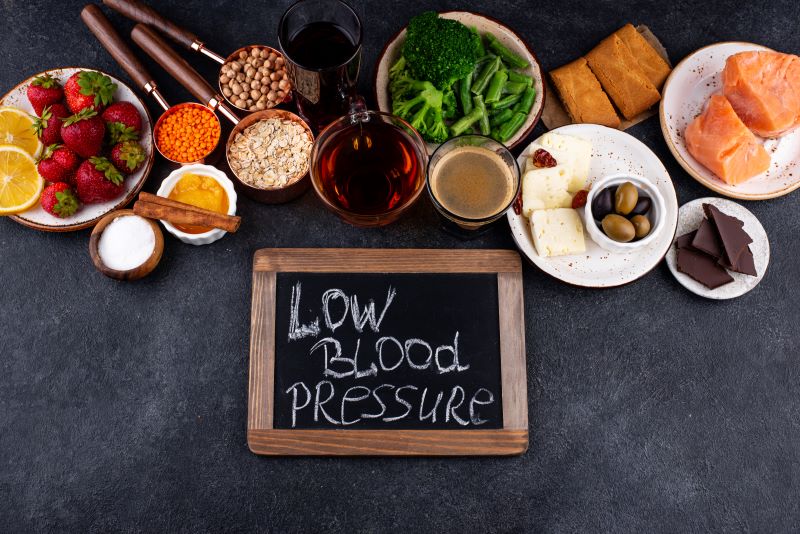
Hypertension, also known as high blood pressure, is a medical condition marked by too much pressure from blood on the walls of arteries. However, eating right and following good practices can help keep it in check.
One could be stirred by curiosity about its effects, seek tips on managing it, or just widen one's understanding of medical conditions through investigation of hypotension itself. Hypotension is curious, so let’s explore it in depth!

Table of Content

Why Maintaining Proper Blood Pressure is Important?
Maintaining proper blood pressure is crucial for overall health and well-being. Let's first delve into the reasons behind it:
- Heart Health: High blood pressure (hypertension) puts extra strain on the heart, leading to conditions like coronary artery disease, heart failure, and heart attacks. Keeping blood pressure within a healthy range reduces the risk of these cardiovascular diseases.
- Stroke Prevention: High blood pressure is the leading cause of strokes. When blood stress is just too high, it can harm blood vessels within the mind, increasing the danger of a stroke. By controlling blood stress, you could lower the hazard of this lifestyle-threatening event.
- Kidney Function: The kidneys play a critical role in regulating blood pressure. High blood pressure can harm the blood vessels inside the kidneys, leading to kidney disease or kidney failure. Maintaining proper blood pressure helps hold kidney features.
- Vision Preservation: Hypertension can damage the blood vessels within the eyes, leading to vision issues and even blindness. Managing blood pressure can help protect vision and eye health.
- Brain Health: Chronic high blood stress is associated with cognitive decline and an elevated danger of dementia. Controlling blood pressure may assist in maintaining mind function as you age.
- Overall Well-being: High blood pressure is often called the "silent killer" as it commonly has a few symptoms until it causes severe headaches. By dealing with blood pressure, you may save those silent threats to your health and enjoy a higher first-class existence.
29 Best Foods to Lower Blood Pressure
Managing blood pressure levels and promoting cardiovascular health largely depend on what we eat daily. Even though genetic and life factors increase one’s risk of suffering from hypertensive situations, eating well-balanced meals can significantly affect blood pressure control.
List of Fruits for Low Blood Pressure
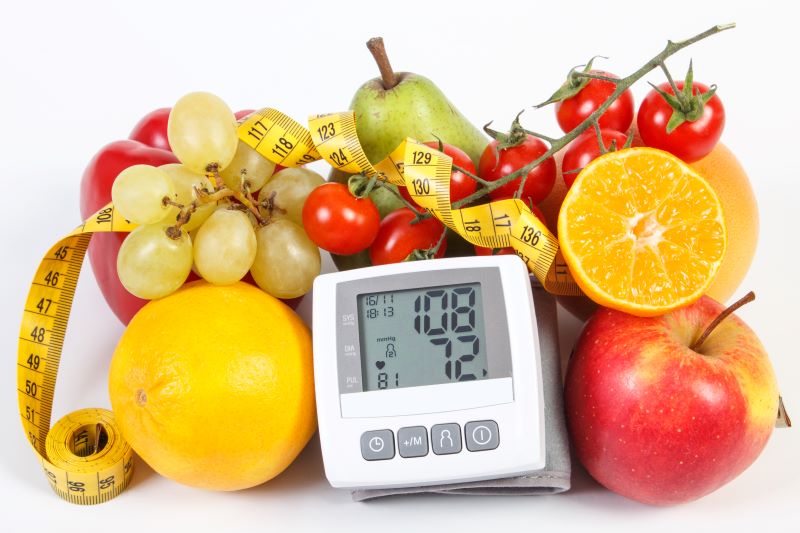
Some fruits are full of fibre, antioxidants, vitamins, and minerals and have been shown to decrease blood pressure naturally. Including these fruits in your diet can help control your blood pressure and improve the health of your heart.
SNo. |
Fruits | Description |
| 1 | Citrus Fruits | These are abundant in antioxidants, including vitamin C and flavonoids, which support the health of the heart and blood vessels. They are also low in sodium and high in potassium and fibre. They are ideal for high blood pressure patients because of all these features. |
| 2 | Berries | Antioxidant chemicals and polyphenols in berries, especially blueberries, can reduce blood pressure and enhance blood vessel health. |
| 3 | Bananas | Known as "superfoods IQ," these nutrient-dense fruits are high in potassium, fibre, magnesium, and antioxidants, all of which help lower blood pressure. |
| 4 | Pomegranate | According to research, pomegranate minerals support heart health by preventing blood vessel hardening, promoting healthy blood flow, and lowering blood pressure and cholesterol. |
| 5 | Prunes | Their high potassium and low sodium content help decrease blood pressure, prevent blood vessel hardening, and support heart health. |
| 6 | Melons | Rich in potassium, vitamin C, folate, and fibre, melons support cardiovascular health and help control blood pressure. |
| 7 | Watermelon | Citruline, an amino acid found in watermelon, helps to produce nitric oxide and makes blood vessels more flexible. This promotes blood flow and may lower the chance of developing high blood pressure. |
| 8 | Kiwi | Kiwis are high in vitamin C, and their green flesh cover is a good source of lutein, a potent antioxidant that lowers blood pressure. |
List of Vegetables that Lower Blood Pressure
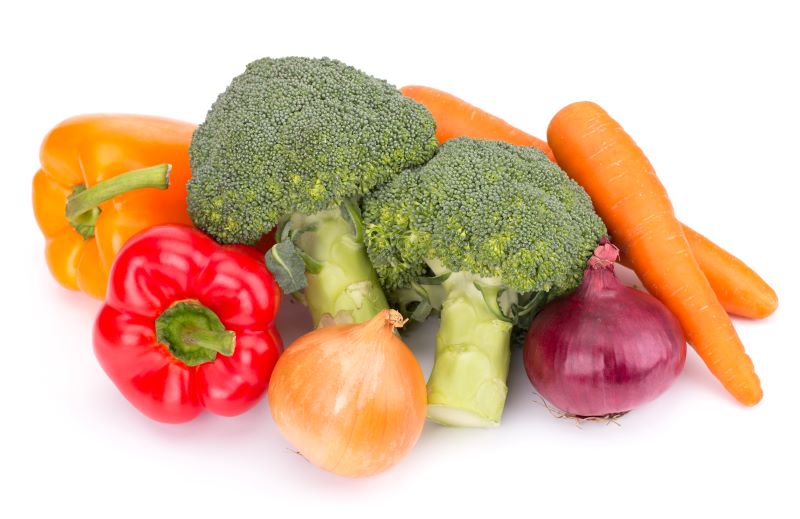
A well-balanced diet must include vegetables, praised for their many health advantages, including the capacity to lower blood pressure. Certain vegetables have been identified for their exceptional ability to support cardiovascular health and decrease blood pressure naturally.
SNo |
Vegetables | Description |
| 9 | Beets | Beets contain high concentrations of inorganic nitrate, which lowers the risk of high blood pressure. High blood pressure can be reduced by consuming one to two cups of beetroot juice daily or by incorporating it into salads. |
| 10 | Sweet Potato | Sweet potatoes are essential for high blood pressure because they are high in potassium and magnesium. They are also high in fibre and work well to maintain heart health. |
| 11 | Broccoli | Potassium, magnesium, calcium, and vitamin C are all found in broccoli. These four miracle substances assist in controlling your blood pressure. |
| 12 | Leafy Vegetable | Leafy foods high in potassium include arugula, spinach, romaine lettuce, cabbage, and others. As previously noted, the kidneys need the maximum amount of potassium in the body to help them excrete more salt through urine, which reduces blood pressure. |
| 13 | Tomatoes | Tomatoes and tomato-based products are excellent providers of lycopene and potassium. Lycopene is a carotenoid pigment that helps prevent heart disease risk factors like high blood pressure. |
| 14 | Carrots | Carrots are one of the best foods for lowering blood pressure. This vegetable contains many phenolic chemicals, including anti-inflammatory and blood vessel-relaxing acids, p-coumaric and chlorogenic. |
List of Dairy Products for Low Blood Pressure
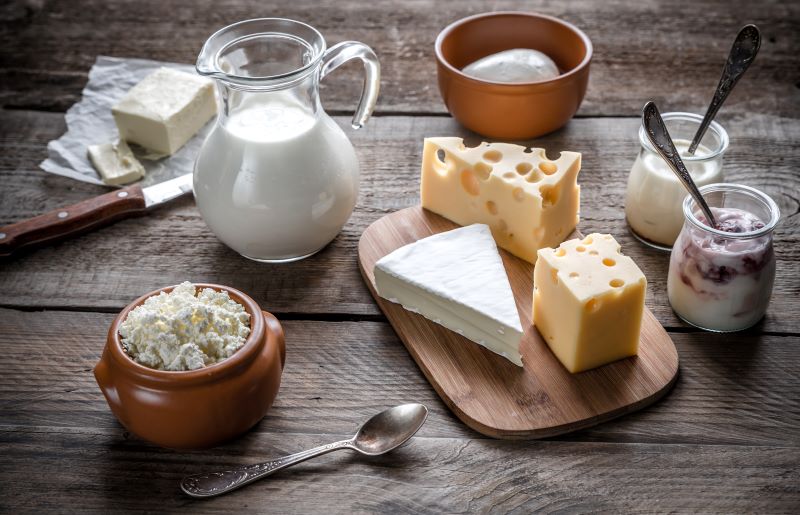
Dairy products, in general, can be included in a heart-healthy diet, but some may have particular qualities that can help lower blood pressure. The following dairy items are typically thought to lower blood pressure:
SNo. |
Dairy Products | Description |
| 15 | Skim Milk | Rich in calcium and low in fat, skim or low-fat milk can be part of a heart-healthy diet. The calcium content may contribute to lower blood pressure. |
| 16 | Greek Yoghurt | Greek yoghurt is higher in protein and lower in sugar than regular yoghurt. It also contains potassium, calcium, and magnesium, which can help regulate blood pressure. |
List of Poultry and Seafood Items that Lower Blood Pressure
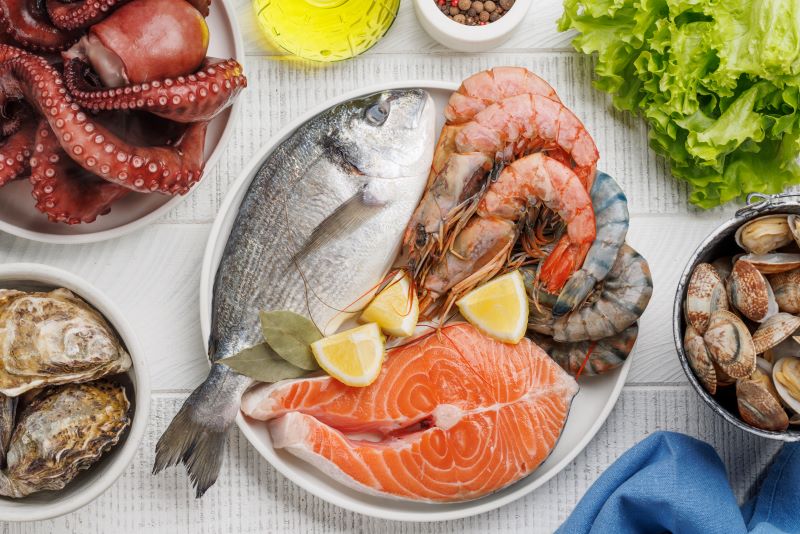
A balanced diet that includes seafood, animal-based options, and lots of fruits, vegetables, whole grains, and healthy fats will help maintain cardiovascular health and control blood pressure.
SNo. |
Poultry and Seafood | Description |
| 17 | Salmon | Salmon is rich in omega-3 fatty acids, particularly EPA and DHA, and consumption has been associated with lower blood pressure levels. |
| 18 | Mackerel | Another fatty fish high in omega-3 fatty acids, mackerel, can help reduce blood pressure when included in a balanced diet. |
| 19 | Sardines | Like salmon and mackerel, sardines are a good source of omega-3 fatty acids, which have been shown to lower blood pressure. |
| 20 | Tuna | Tuna is also rich in omega-3 fatty acids, making it a heart-healthy choice that may help lower blood pressure. |
| 21 | Shellfish(Shrimp,Lobster,Crab) | Shellfish are low in saturated fat and high in protein. They also contain nutrients such as magnesium and potassium, which can help regulate blood pressure. |
| 22 | Lean Protein(Chicken, Turkey) | Lean cuts of skinless poultry are good protein sources and can be included in a heart-healthy diet to help manage blood pressure. |
| 23 | Lean Cuts of Beef and Pork | While red meat should be consumed in moderation, lean cuts of beef and pork can be part of a balanced diet. Opt for cuts with less marbling and trim visible fat to reduce saturated fat intake. |
Calculate Your Health Metrics Instantly
List of Other Food Items that Lower Blood Pressure

Apart from foods derived from animals and shellfish, several additional foods have the potential to reduce blood pressure because of their high nutrient content and health benefits. The following is a list:
SNo. |
Food Items | Description |
| 24 | Quinoa | A half-cup of quinoa provides approximately 15% of the daily required magnesium intake, making it a super grain. Its high fibre content lowers blood pressure and makes it an excellent source of plant-based protein. |
| 25 | Amaranth | Amaranth's high magnesium levels aid in producing nitric oxide, which relaxes blood vessels and lowers blood pressure. A cup of cooked amaranth provides 38% of the required magnesium intake. |
| 26 | Pulses | Many people's staple diets consist of pulses like beans and lentils. These are excellent sources of potassium, magnesium, fibre, and vegetarian protein, all of which help to control blood pressure. |
| 27 | Pumpkin Seeds | The magnesium, arginine, and amino acids in pumpkin seeds help produce nitric oxide, which relaxes blood vessels and lowers blood pressure. |
| 28 | Pistachio | Pistachios are one of the healthiest foods to eat with high blood pressure. They contain nutrients like potassium, which helps lower systolic and diastolic blood pressure. |
| 29 | Dark Chocolate | Dark chocolate flavonoids aid in producing nitric oxide, which eases blood vessel tension and reduces blood pressure. To improve your mood and maintain your health, buy premium dark chocolate with at least 70% cocoa and consume one square per day. |
Factors That Influence Low Blood Pressure
Blood pressure, the force exerted by circulating blood against the walls of blood vessels, is a vital physiological parameter that reflects the health of the cardiovascular system. It is influenced by a complex interplay of factors such as:
- Cardiac Output: This refers to the amount of blood pumped by the heart per minute. It's calculated by multiplying the heart rate (number of beats per minute) by stroke volume (the amount of blood pumped by the heart with each beat). If cardiac output increases, blood pressure tends to rise.
- Peripheral Vascular Resistance (PVR): PVR is the resistance offered by the blood vessels to the flow of blood. The diameter of the arterioles primarily determines the small branches of arteries. When the arterioles constrict, PVR increases, leading to higher blood pressure. Conversely, when they dilate, PVR decreases, resulting in lower blood pressure.
- The Volume of Circulating Blood: This refers to the total volume of blood circulating through the body. If the volume of blood increases (for example, due to fluid retention or excessive intake of fluids), blood pressure tends to rise. Conversely, if blood volume decreases, blood pressure tends to decrease.
- Viscosity of Blood: Blood viscosity refers to the thickness or stickiness of blood. High blood viscosity can impede blood flow, increasing resistance and blood pressure. Factors influencing blood viscosity include hematocrit (the proportion of red blood cells to total blood volume) and plasma proteins.
- Elasticity of Vessel Walls: Arteries have elastic properties that allow them to stretch and recoil with each heartbeat. The elasticity of vessel walls affects how efficiently blood is pumped through the circulatory system. Loss of elasticity, often associated with conditions like arteriosclerosis (hardening of the arteries), can lead to increased blood pressure.
What are the Foods to Avoid for High Blood Pressure?
Certain meals have the potential to worsen hypertension in people by raising blood pressure or encouraging other cardiovascular risk factors. The following food list should be limited or avoided if you have high blood pressure:
- Sodium-rich foods: Excessive sodium intake can cause fluid retention and increase blood pressure. Avoid or limit processed and packaged foods, canned soups, salty snacks, and fast food, as they tend to be high in sodium.
- Processed Meats: Deli meats, bacon, sausage, and other processed meats are often high in sodium and unhealthy fats, contributing to high blood pressure and other cardiovascular problems.
- High-Sodium Condiments: Soy sauce, teriyaki sauce, ketchup, and salad dressings can be significant sources of hidden sodium. Opt for low-sodium or sodium-free versions, or use herbs, spices, lemon juice, or vinegar to add flavour to your meals.
- Canned and Pickled Foods: Canned vegetables, pickles, olives, and other pickled foods are typically high in sodium. Choose fresh or frozen vegetables and fruits whenever possible, and rinse canned vegetables to reduce their sodium content.
- Sugar-Sweetened Beverages: Regular consumption of sugary drinks like soda, sweetened iced tea, and fruit juices can contribute to weight gain and insulin resistance, both risk factors for high blood pressure and heart disease.
- High-Caffeine Beverages: While moderate caffeine consumption is generally safe for most people, excessive caffeinated beverages like coffee, energy drinks, and some teas may temporarily increase blood pressure.
- Alcohol: Drinking too much alcohol can raise blood pressure and contribute to other cardiovascular problems. Limit alcohol consumption to moderate levels (up to one drink per day for women and up to two drinks per day for men).
- High-Fat Foods: Foods high in saturated and trans fats, such as fried foods, fatty meats, full-fat dairy products, and commercially baked goods, can contribute to high blood pressure and cholesterol levels.
- Excessively Salty Snacks: Chips, pretzels, salted nuts, and other salty snacks are high in sodium and low in nutrients. Opt for healthier snacks like unsalted nuts, seeds, air-popped popcorn, or fresh fruits and vegetables.
- High-Dough Foods: Pizza, pastries, pies, and other foods made with high-fat dough can contain unhealthy fats and sodium, contributing to high blood pressure and other cardiovascular issues.
What is a Healthy Diet for Normal Blood Pressure?
Dietary Approaches to Stop Hypertension (DASH) is a nutritious eating plan designed to help manage or prevent hypertension or high blood pressure. It may also help lower low-density lipoprotein (LDL) cholesterol, which is linked to heart disease.
The DASH diet is high in magnesium, calcium, and potassium foods. The DASH diet emphasizes:
Whole grains
Fruits
Vegetables
Fish
Chicken
Legumes
Nuts
Low-fat or fat-free dairy products.
Foods heavy in sodium, sometimes known as salt, are restricted. Additionally, it restricts saturated fat and added sugar, which are found in fatty meats and full-fat dairy products.
Side Effects of an Unhealthy Diet on Blood Pressure
Hypertension, another name for high blood pressure, is a severe risk factor for several illnesses and has repercussions that go beyond cardiovascular problems. The following are some possible adverse reactions and medical issues linked to poorly controlled or uncontrolled high blood pressure:
- Poor Nutrition: Individuals with high blood pressure may be advised to follow dietary restrictions, such as reducing sodium intake and limiting processed foods. Poor nutrition can lead to deficiencies in essential nutrients, contributing to overall health problems and compromising the body's ability to regulate blood pressure.
- Overweight and Obesity: High blood pressure is closely linked to overweight and obesity. Excess body weight, especially abdominal obesity, can lead to insulin resistance, dyslipidemia, and inflammation, all of which contribute to high blood pressure and increase the risk of cardiovascular disease.
- Heart Disease and Stroke: Chronic hypertension can damage the arteries over time, leading to atherosclerosis (hardening and narrowing of the arteries), coronary artery disease, and an increased risk of heart attack and stroke. High blood pressure strains the heart, causing it to work harder to pump blood throughout the body, eventually weakening the heart muscle and leading to heart failure.
- Type 2 Diabetes: Hypertension and type 2 diabetes often coexist and share common risk factors, such as obesity and sedentary lifestyle. High blood pressure can contribute to insulin resistance, impairing glucose metabolism and increasing the risk of developing type 2 diabetes. Conversely, diabetes-related complications, such as kidney disease and diabetic retinopathy, can exacerbate hypertension.
- Cancer: While the direct relationship between high blood pressure and cancer is not fully understood, some studies suggest that chronic inflammation and oxidative stress associated with hypertension may contribute to the development and progression of certain cancers. Additionally, specific cancer treatments, such as chemotherapy and radiation therapy, can affect blood pressure and cardiovascular health.
- Kidney Disease: Hypertension is a leading cause of chronic kidney disease (CKD) and end-stage renal disease (ESRD). High blood pressure can damage the small blood vessels in the kidneys, impairing their ability to filter waste and regulate fluid balance. Conversely, kidney dysfunction can exacerbate hypertension by disrupting the body's salt and water balance and increasing blood pressure.
- Vision Problems: Hypertension can affect the blood vessels in the eyes, leading to retinopathy (damage to the retina), hypertensive retinopathy, and other vision problems. Untreated hypertension can increase the risk of vision loss and blindness due to complications such as retinal vein occlusion and optic nerve damage.
Protect What Matters - Explore Other Insurance Options
















